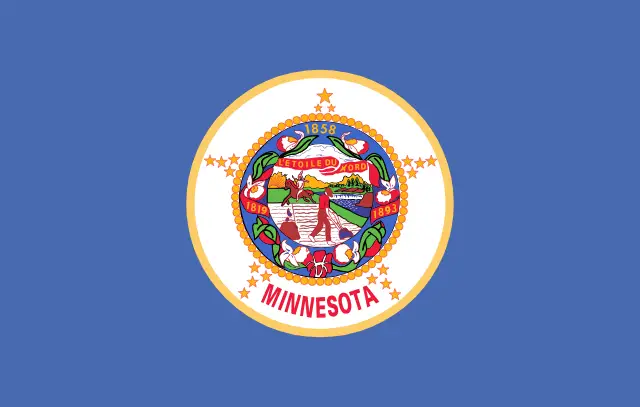State of Minnesota
Nicknames: The North Star State, The Land of 10,000 Lakes
Motto(s): L’Étoile du Nord (The Star of the North)
Date of Statehood: May 11, 1858 (32nd state)
State Song: “Hail! Minnesota” by Truman E. Rickard and Arthur E. Upson
Minnesota Flag History
The flag of Minnesota, adopted in 1893 and modified in 1957, represents the state’s history, natural beauty, and values. The flag is royal blue, with a gold fringe. In the center of the flag is the state seal, and surrounding it are a wreath of the state flower, the lady’s slipper, and nineteen stars, symbolizing Minnesota as the 19th state to enter the Union after the original 13.
The state seal depicted in the flag features a farmer plowing a field and an Indigenous person riding a horse toward the sunset. The scene is meant to represent the Native American heritage and the agricultural nature of the state. The three dates on the seal represent the year of statehood (1858), the year Fort Snelling was established (1819), and the year the official flag was adopted (1893).
The flag’s design reflects the state’s pride in its history, agriculture, industry, and natural resources. It symbolizes the spirit of progress, the importance of the state’s natural and human resources, and respect for its diverse heritage.
Minnesota Quick Facts
Capital City: St. Paul
Abbreviation: MN
Population: Approximately 5.6 million
Region: Midwest, Great Lakes
Origin of State Name: Derived from the Dakota Sioux word “Mní sóta,” meaning “clear blue water”
Sports Teams: Minnesota Vikings (NFL), Minnesota Twins (MLB), Minnesota Timberwolves (NBA), Minnesota Wild (NHL)
Bordering States: Wisconsin, Iowa, South Dakota, North Dakota, and the Canadian provinces of Ontario and Manitoba
Area Codes: 218, 320, 507, 612, 651, 763, 952
Highest Point: Eagle Mountain at 2,301 feet (701 meters)
Lowest Point: Lake Superior at 601 feet (183 meters)
Geography of Minnesota
Area: 86,936 square miles (225,163 square kilometers), 12th largest
Land: 79,627 square miles (206,233 square kilometers), 14th largest
Water: 7,309 square miles (18,930 square kilometers), 10th largest
Coastline: None (landlocked state)
Shoreline: 44,926 miles (72,301 kilometers), including lakes and rivers
Largest Cities:
- Minneapolis
- St. Paul
- Rochester
- Duluth
- Bloomington
- Brooklyn Park
- Plymouth
- Woodbury
- Maple Grove
- St. Cloud
- Eagan
- Eden Prairie
- Coon Rapids
- Burnsville
- Blaine
National Parks:
- Voyageurs National Park
- Mississippi National River and Recreation Area
- Pipestone National Monument
- Grand Portage National Monument
Minnesota State Symbols
Living Insignia
State Bird: Common Loon
State Animal: Eastern Timber Wolf
State Amphibian: None
State Butterfly: Monarch Butterfly
State Fish: Walleye
State Flower: Pink and White Lady’s Slipper
State Horse Breed: None
State Insect: Monarch Butterfly
State Mammal: Eastern Timber Wolf
State Reptile: None
Inanimate Insignia
State Fruit: Honeycrisp Apple
State Gemstone: Lake Superior Agate
State Soil: Lester
State Tree: Red Pine
State Quarter: Issued in 2005 featuring a tree-lined lake with a common loon in the foreground and a textured outline of the state with the state motto “Land of 10,000 Lakes”
State Beverage: Milk
State Colors: None official
State Dance: Square Dance
State Food: Wild Rice
State Fossil: None
State Mineral: Iron Ore
State Rock: Lake Superior Agate

